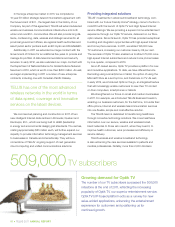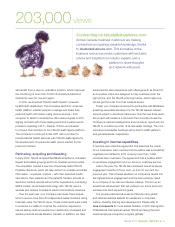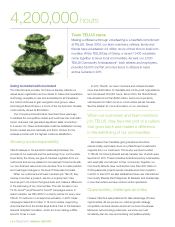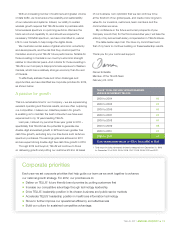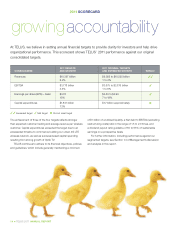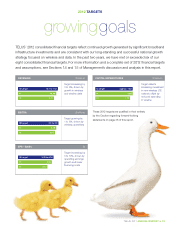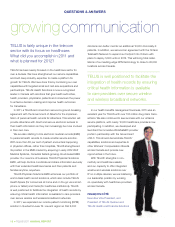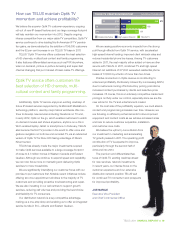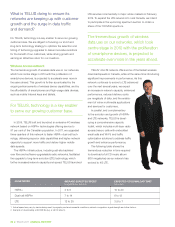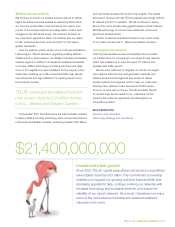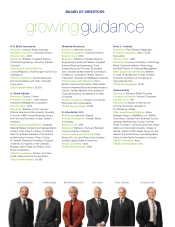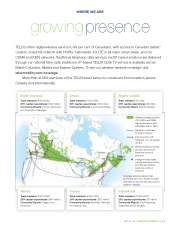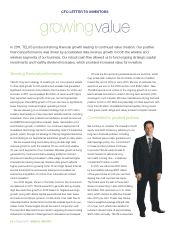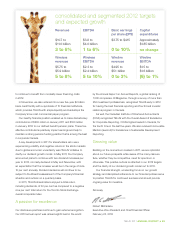Telus 2011 Annual Report Download - page 24
Download and view the complete annual report
Please find page 24 of the 2011 Telus annual report below. You can navigate through the pages in the report by either clicking on the pages listed below, or by using the keyword search tool below to find specific information within the annual report.
20 . TELUS 2011 ANNUAL REPORT
LTE services commercially in major urban markets in February
2012. To expand the LTE network into rural Canada, we intend
to participate in the upcoming spectrum auction to obtain a
share of the 700 MHz spectrum.
The tremendous growth of wireless
data use on our networks, which took
centre stage in 2010 with the proliferation
of smartphone devices, is projected to
accelerate even more in the years ahead.
TELUS’ 4G LTE network offers some of the fastest wireless
download speeds in Canada, while at the same time introducing
significant improvements in performance. As this
network continues to evolve to LTE-advanced
over the next several years, we expect
an increase in network capacity, enhanced
performance, reduced delivery costs
per megabyte of data, and the enable-
ment of richer multimedia applications
and services for customers.
In parallel, and complementary
to the evolution and growth of HSPA+
and LTE networks, TELUS is devel-
oping a comprehensive capacity
toolkit, which includes multi-layer radio
access (macro cells with embedded
small cells and Wi-Fi) and traffic
optimization solutions to address traffic
growth and enhance performance.
The following table shows the
tremendous reduction in time required
to download a full CD music album
(600 megabytes) as our network has
evolved to 4G LTE.
What is TELUS doing to ensure its
networks are keeping up with customer
growth and the surge in data traffic
and demand?
For TELUS, technology is a key enabler to serve our growing
customer base. We are diligent in focusing our short and
long-term technology strategy to optimize the selection and
timing of technology upgrades to deliver innovative solutions
for the benefit of our customers, while driving growth and
earning an attractive return for our investors.
Wireless access network
The tremendous growth of wireless data use on our networks,
which took centre stage in 2010 with the proliferation of
smartphone devices, is projected to accelerate even more in
the years ahead. This growth is further accentuated by the
ongoing enhancements of wireless device capabilities, and by
the affordability of smartphones and high-usage data devices,
such as mobile Internet keys and tablets.
For TELUS, technology is a key enabler
to serve our growing customer base.
In 2009, TELUS built and launched an extensive 4G wireless
network based on HSPA+ technologies offering service to
97 per cent of the Canadian population. In 2011, we upgraded
three-quarters of this network to faster HSPA+ dual-cell tech-
nology, delivering superior data capabilities and higher network
capacity to support more traffic and deliver higher mobile
data speeds.
The HSPA+ infrastructure, including cell-site backhaul
over fibre and software-upgradeable radio networks, facilitated
the upgrade to long-term evolution (LTE) technology, which
further increased network capacity and speed. TELUS launched
4G NETWORK AVERAGE EXPECTED SPEED1
(megabits per second)
EXPECTED CD DOWNLOAD TIME2
(minutes)
HSPA+ 4 to 6 10 to 20
Dual-cell HSPA+ 7 to 14 6 to 12
LTE 12 to 25 3.5 to 7
1 Actual speed may vary by device being used, topography and environmental conditions, network congestion, signal strength and other factors.
2 Example of downloading a 600 MB file (e.g. a full CD album).


